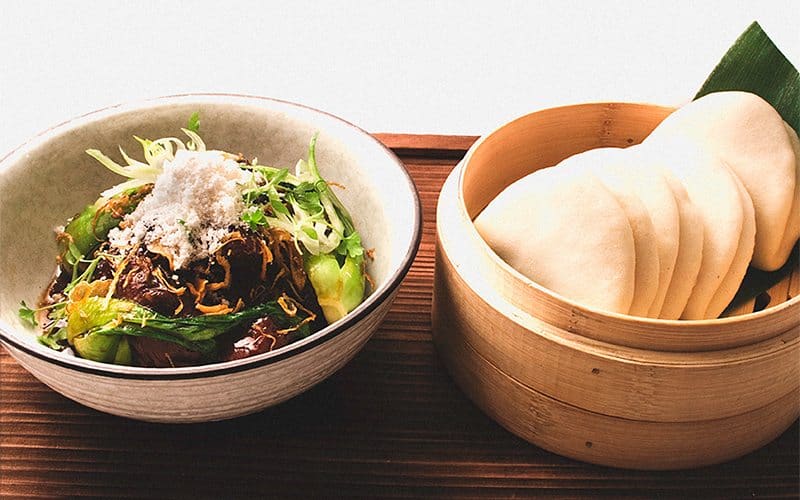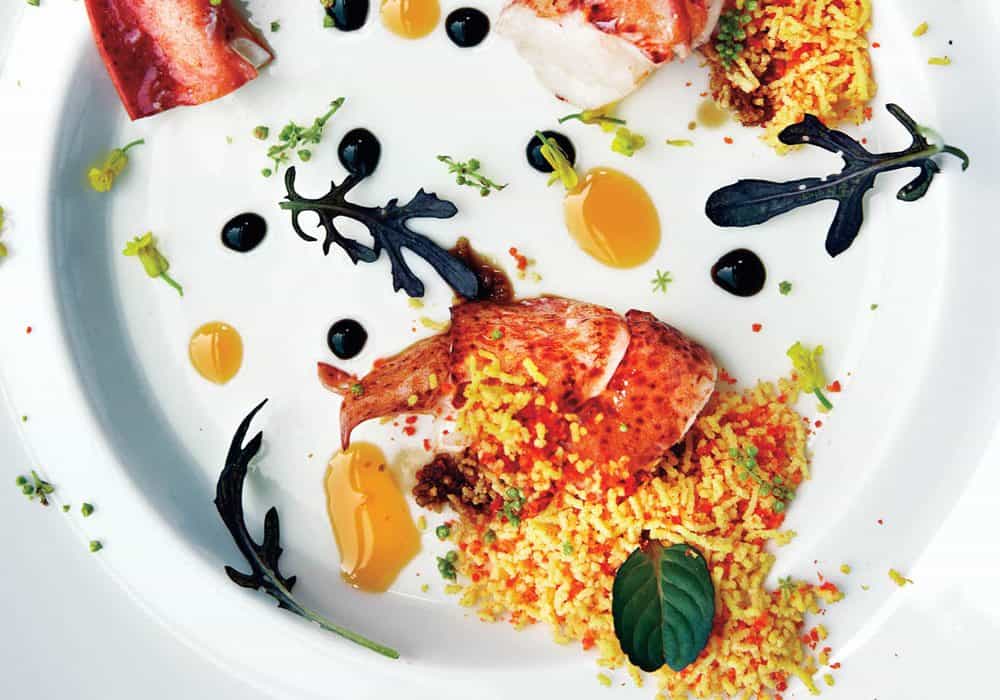
By Chef-Owner at Maenam, Angus An
I learned the basic version of this dish from my mother, who got it from my grandmother.
Like a lot of traditional Thai dishes, it has its roots in Chinese cooking— in this case, from the off-cut (pork cheek), the method (cold-blanching and braising), and the rich, fragrant spicing that enhances the mix. One day when I was making it the way my mother showed me, I happened to have some leftover fresh truffles sitting about from a private dinner I’d been hired to do. The smell of the spices in the braise mingled with the aroma of the truffles in my kitchen so well that I just thought: Why not? That’s how I came up with my twist on this traditional family dish.
– Angus An
Braise:
- ¼ tsp white peppercorns
- 2 pieces star anise
- 1 tsp dried orange peel
- 2 cm (1 inch) piece cassia (or cinnamon) bark
- 2 L (about 8 cups) chicken stock
- 60 mL (¼ cup) oyster sauce
- 60 mL (¼ cup) Thai fish sauce
- 2 pandan leaves
- 1.5 kg (3½ lb) pork cheek
To finish:
- 100 g (4 oz) palm sugar
- 2 pieces orange zest
- White pepper
- 2 tbsp crisp-fried shallots*
- 1 tsp crisp-fried garlic chips*
- Asian celery leaves (or julienned celery, or chopped cilantro)
- Freshly shaved truffle, or top-quality truffle oil
Accompaniment:
- Steamed buns
- Blanched or steamed baby bok choy
Makes
4 Servings
Pre-heat oven to 135°C (275°F).
In a dry skillet over low heat, lightly toast the peppercorns, star anise, orange peel and cassia bark until fragrant, then transfer to a Dutch oven. Add the chicken stock, oyster sauce, fish sauce and pandan leaves, and bring to a gentle simmer. Meanwhile, trim the silverskin from the pork cheeks. Transfer to a large saucepan, cover with cold water, and place on high heat. As soon as the water comes to a boil, use a slotted spoon to remove the pork cheeks to the chicken stock mixture. Cover and transfer to the oven. Braise until the meat is tender and yields easily when pierced with a fork—about three hours. When the pork is done, transfer the pot to the countertop to cool (leave the pork submerged in its braising liquid). When the pot nears room temperature, move it to the refrigerator to chill overnight. The next day, remove the congealed fat from the surface of the braising liquid and discard. Gently reheat. As soon as braising liquid liquefies use a slotted spoon to remove the pork. Wrap each piece snugly in plastic wrap and refrigerate until needed. Strain and reserve the braising liquid (discard the solids).
To make the sauce, caramelize the sugar with 1 tbsp of water in a heavy-bottomed saucepan on medium heat. Once it is bronzed and bubbling, carefully add the strained braising liquid to the pan, whisking vigorously all the while. Add the zest. Reduce the liquid to a glaze—it should be thick enough to coat the back of a spoon. Taste and correct seasonings—add white pepper if needed, and fish sauce if too sweet. Then gently reheat the pork in its sauce.
Arrange in a warm bowl, garnished with shallots, garlic, celery leaves and truffle (or truffle oil). Serve with bok choy warm and steamed buns.
*Slice thin and shallow-fry at 160°C (325°F) until golden and crisp. Or buy pre-made at an Asian grocer.




